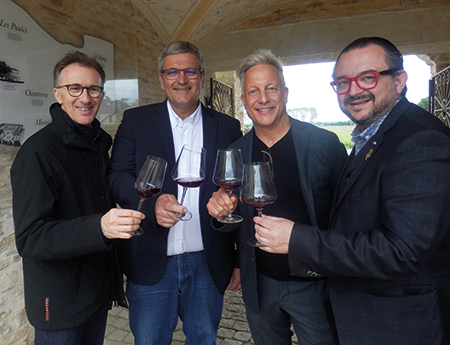Since 2014, American Michael Baum has breathed new life into Château de Pommard. Restoration of the buildings, new winery, transition to biodynamics. Last innovation: a plot-selection bottling of the 20-hectare Clos.

“The clos is composed of seven plots, each with their own characteristics. Simone and Chantrerie are the richest in clays, they form the spirit and soul of the grand wine”. Emmanuel Sala, technical director of Château de Pommard, sets the tone. Since he took over the reins of the estate, his knowledge of the vineyard has been refined. A question of empiricism of course but not only. The Clos has been the subject of soil studies conducted by the famous agricultural engineers Lydia and Claude Bourguignon, which have made it possible to identify the quality of the soils.
An approach that was accompanied by a move to biodynamics initiated in 2016. The team isolated 2.5 ha on the localities Simone and Chantrerie to practice there this demanding farming method. A draft horse has notably appeared in the Clos. Emmanuel Sala and Michael Baum call on a consultant to accompany them: Antoine Lepetit de la Bigne, oenologist and agronomist. He spent eight years at Domaine Leflaive (Puligny-Montrachet) and specialized in the monitoring of vineyards.
From the vineyard to the wine the step was naturally crossed: the plot called Simone, 0.53 ha which presents the geo-pedological characteristics of a great terroir for Pinot Noir, has become the iconic wine of the Château. A name whose origin remains mysterious but which now appears in full letters on bottles specially edited and packaged (1,800 copies in good years) to hold this cuvée.

Before giving life to Simone, the team of the Château has reconnected with the historic name of its vineyard: Clos Marey-Monge. In any case, that is how the 20 hectares of vines were designated by Jules Lavalle in his famous book “History and statistics of the vineyard and the great wines of Côte d'Or” published in 1855. The name 'Clos du Château Pommard' did appear only in 1936, making disappear the reference to the famous family who had long been the owners.
The Marey-Monges were one of the largest family of vineyard owners in Burgundy from the late 18th century. It has owned many vineyards in Burgundy including Romanée-Saint-Vivant, Clos de Tart, Richebourg, Bonnes-Mares, ... “Thus the revival of Clos Marey-Monge is a strong symbol of our desire to go forward in respect of these traditions,” says Michael Baum, Californian owner of the Château since 2014.
One entity but several terroirs. They are vinified and aged separately before being blended to give the Clos Marey-Monge cuvée. With the 2017 vintage, Michael Baum has for the first time decided to bottle a part of each cuvée separately. The lovers of Château de Pommard will be able soon to be initiated with the plot variations of the Clos.
Laurent Gotti
Château de Pommard, AOC Clos Marey-Monge Chantrerie 2017
Light clear ruby-red colour with garnet-red shades. Discreet nose that opens up after a good oxygenation on smoked aromas, cherries in alcohol, cloves and green pepper. Powerful and tasty palate, with a very pleasant sweet note, a mid-palate of rather rich structure, firm and fairly round tannins, a rather persistent and tasty finish. Ageing: 2021-2028
Château de Pommard, AOC Clos Marey-Monge 2017
Light ruby-red with garnet-red hues. Discreet nose with hints of black cherry, currants, wild strawberries, cloves. On the palate, rich and dense, voluminous and brawny, a beautiful structure in the mid-palate, firm tannins, a rather persistent finish with a fairly lush style. Ageing: 2021-2028